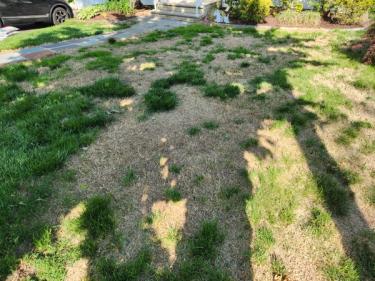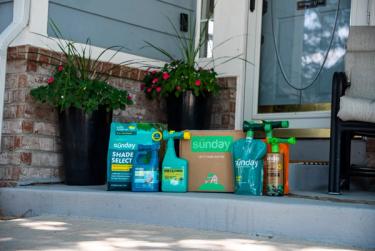Ready to take your lawn care game to the next level? While other homeowners are storing their mowers for winter, savvy lawn owners know that now is the perfect time to plan for a greener, healthier lawn next season. This lawn improvement guide will walk you through proven methods used by turf professionals to create a sustainable, resilient yard care routine.
What you'll learn
- How to evaluate your current lawn care practices
- Which lawn care methods work best for your yard
- Setting realistic lawn improvement goals
- Planning major yard upgrades
- Creating a sustainable lawn care schedule
Step 1: Audit your current lawn care routine

Every great lawn routine starts with understanding what you're already doing right. Let's break down your current practices into two categories: essential maintenance and advanced care.
Essential maintenance
- Good mowing practices (correct height and frequency)
- Strategic watering schedule
- Sunday fertilizer applications
- Basic weed management
Advanced care
- Soil testing and amendment
- Strategic overseeding
- Core aeration (only when you need it!)
- Advanced turf pest management (again, if you need it!)
Sunday Tip:
Don't worry if you're mostly focusing on essential maintenance right now. Building a healthy lawn is a journey, and mastering the basics creates a strong foundation for more advanced practices.
Step 2: Evaluate your lawn care success
Now comes the honest part—looking at what worked and what didn't. Remember: even experienced lawn owners face challenges, so be kind to yourself while being truthful about your results.
Success factors
Take note of practices that showed positive results:
- What specific conditions led to success?
- Which tools or methods were most effective?
- How can you replicate these winning strategies?
"My fall weed control approach worked great because I stayed consistent with the application schedule and applied full coverage treatments during good weather conditions."
Areas for improvement
Identify where you faced challenges:
- What were the main obstacles you encountered?
- Which resources or knowledge were you missing?
- What would have made these tasks easier?
"It was really challenging to water my lawn correctly during the hottest summer months. I meant to upgrade to a smart watering timer, but just lost track of it."
Sunday Tip:
Sometimes what works in spring might not work in summer. Weather, time constraints, and other life factors all play a role in your lawn care success.
Step 3: Set new lawn care goals
Now that you know what worked and what didn't, it's time to plan some practical improvements. Here are our top recommendations for impactful lawn care resolutions:
Essential improvements
- Schedule irrigation system audits for spring and fall
- Adjust mowing heights seasonally (higher in summer, lower in fall)
- Plan two annual mower blade sharpenings
- Create a strategic seeding schedule (one primary and one secondary)
- Develop a smarter watering routine to prevent disease
Pro Tip: Choose just 1-2 goals to focus on first. Set calendar reminders for these tasks now, while you're planning.
Step 4: Plan major lawn improvements now (versus later)

When your lawn looks like this, you may require some major lawn repair this season. Ready to tackle bigger projects? Here's how to approach major lawn renovations:
Renovation projects
- Soil testing how-tos
- Soil amending (and for lighter soil issues: topdressing)
- New sod installation
- Drainage improvement
- Starting a new lawn
Sustainable upgrades
- Rain garden installation
- Turf (aka lawn) removal
- Drought-resistant landscaping
- Starting a native garden
Pro Tip: Major projects require more planning. Research required tools and materials now, and consider whether you'll need professional help.
Step 5: Create your lawn care timeline
Success comes from having a clear plan. Here's how to organize your lawn care calendar:
Winter (planning season)
- Order lawn supplies and tools
- Schedule equipment maintenance
- Plan major spring projects
- Review and adjust lawn care budget
Spring (growth season)
- Begin mowing when grass reaches ~3-4 inches
- Apply first round of Sunday custom lawn plan
- Inspect and audit irrigation system
- Light overseeding and patch bare spots if needed
Summer (maintenance season)
- Primary overseeding and planting time for warm-season lawns
- Adjust mowing height up
- Monitor water needs closely and adjust!
- Watch for signs of stress or lawn disease
- Maintain consistent feeding schedule
Fall (recovery season)
- Repair summer lawn damage
- Primary overseeding time for cool-season lawns
- Fall weed control for winter annuals and perennial weeds
- Core aeration (if needed!)
- Continue fall fertilizer applications
- Prepare for winter
Bonus: Level up your sustainable lawn care

Want to make your lawn more resilient to climate change? Here are our favorite eco-friendly upgrades:
Water conservation
- Install smart irrigation controls
- Switch to drip systems where possible
- Collect rainwater for garden use
Sustainable mowing
- Practice grasscycling (leave clippings)
- Maintain higher mowing heights
- Reduce mowing frequency for pollinator health
Smart planting
- Introduce diverse grass species
- Add clover for natural nitrogen
- Choose native grass varieties (like buffalograss or fescues!)
Sunday Tip:
Did you know Sunday isn't just for lawns? There's an entire Sunday Garden line of fertilizers, soils and soil amendments for all your gardening needs.
Getting started on your lawn resolution

Building a better lawn is a marathon, not a sprint. Focus on steady improvements, and you'll see your lawn transform into a more resilient, sustainable landscape year after year.
Ready to start your lawn improvement journey? Download our free lawn care planning template and get personalized recommendations for your yard with Sunday's custom lawn plan.
Download Sunday Lawn Planning Template (2025)
Let's get growing
Our lawn engine uses satellite data to map out your lawn size and determine things like average rainfall, common weeds, and pest activity.












